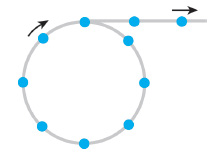Optipedia • SPIE Press books opened for your reference.
Harmonic Mode Locking
Excerpt from Field Guide to Laser Pulse Generation
Harmonic mode locking is a technique for achieving higher pulse repetition rates and is mainly applied to actively mode-locked lasers. The principle is that multiple pulses circulate in the laser resonator with equal spacing. The figure below shows this schematically for a fiber ring laser.

Equidistant multiple pulses become possible simply by driving the modulator of an actively mode-locked laser with a harmonic of the resonator's round-trip frequency. However, this does not guarantee that the pulses have equal pulse energies. It might even occur that certain pulses are missing (pulse dropout). Furthermore, the pulses are not always mutually phase coherent, which might or might not matter, depending on the application.
For passively mode-locked lasers, it can also be a challenge to ensure a constant pulse spacing: pulses might occur in bunches, rather than regularly spaced.
A number of more or less sophisticated techniques have been developed in order to solve the problems mentioned here. For example, spectral filters in the form of resonant subcavities can be inserted into the laser resonator. Electronic feedback systems are also often required. The complexity of the system is thus increased.
Nevertheless, a carefully stabilized harmonically modelocked laser can exhibit lower noise than a fundamentally mode-locked laser, essentially because the noise influence per second on a pulse is smaller.
R. Paschotta, Field Guide to Laser Pulse Generation, SPIE Press, Bellingham, WA (2008).
View SPIE terms of use.

